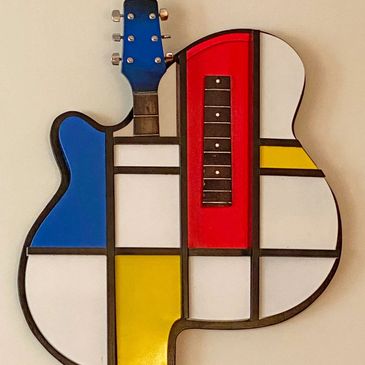
Artist's Statement
Many years back, I disassembled a battered vintage guitar and rearranged the elements in a composition reminiscent of the early cubist painter style. Once finished, I could see that my artwork still had the essence of a guitar, but was now enhanced with refreshing new geometry. Three Dimensional (3D) Cubism had jumped off my canvas!.
More recently, a newer project required piano disassembly. Inside I found the results of amazing workmanship – Magnificent complexities in thousands of intricately hinged, wooden parts; wonderful themes, variations of themes, and rhythms etched in its construction. Certainly such beauty should be exposed where it could be seen and enjoyed. I assembled many of these wonderful elements to form a 24" x 36" sculpture titled "My Be Flat Piano." Flat indeed, it was barely 3” thick! On its back, I scribed a few words: “Look now to enjoy the themes and variations on the themes from the internal precision and magnificent rhythms of my ‘Be Flat Piano.’ No longer too heavy to carry, albeit finally out of tunes."
Today, I peer inside everyday items, scrounged from attics and junk shops, to find hidden beauty that I can expose in new art. Printed circuit boards and computer parts pack shelves in my raw materials inventory, where violins and guitars also await implementation, as project ideas unfold. I hope you enjoy experiencing familiar items set in new forms, one-of-a-kind combinations that foster traditional cubism to rise off the canvas, out into tactile, three-dimensional reality.
ABOUT DIXON BERGMAN
A contemporary artist whose tool set goes far beyond brushes and paints, Dixon Bergman taps cameras, computers, digital printers, and a complete woodworking shop as his arsenal. Continuously learning in the context of creative experimentation, Dixon considers himself a “Constructionist." His work has been exhibited with numerous regional art associations in both Florida and Massachusetts. Solo exhibits of his 3D works include: The Jeanne Horan Gallery in Marshfield, Massachusetts, sponsored by The North River Art Society; The Light, Space & Time Online Gallery, which listed him among the Top 25 3D Artists to Watch; and Scituate Senior Center’s Joanne Vignoni Papandrea Gallery, Scituate, Massachusetts. Internationally, Dixon’s work can be viewed at a permanent installation at the FIVE HOTELS penthouse on Lake Zurich, Switzerland.
Dixon earned a bachelor’s degree in mechanical engineering from Union College and has engaged in graduate programs at Yale School of Art. In his earlier career, he gained 30 years of experience as the creative director of an industrial advertising agency and today devotes his work full time to his artistic passion.
3D Art reproductions that the visually impaired can enjoy through touch
These museum reproductions are constructed using a flat panel made of wood as the "canvas." Design elements are glued to the substrate piece-by-piece, layer upon layer. Surfaces are smoothed, carefully blended and primed before color is applied ... all in an attempt to be faithful both to the color palette and brush textures of the original painting.


